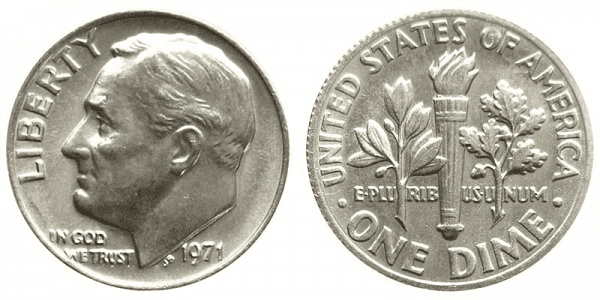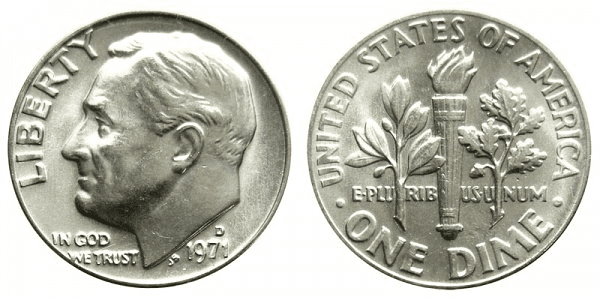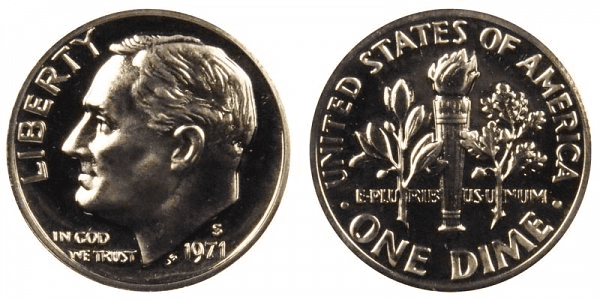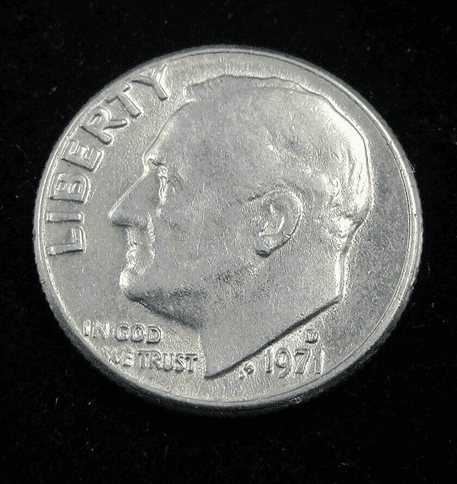What Is A 1971 Roosevelt Dime Made Of?
The Roosevelt Dime was created by the US Mint in 1971. Because it is formed of clad metal, this coin has a solid copper inner core and a coating of copper and nickel on the outside (91.67 percent Copper – 8.33 percent Nickel). Because the 1971 Dime has no silver content, it will be worth its face value until unusual circumstances arise (such as errors or flawless condition).
The obverse of the coin bears the words “Liberty, In God We Trust,” the year, and the designer’s initials, JS. The reverse of the coin reads “United States of America, E Pluribus Unum, One Dime.”
The coin’s reverse, or back side, features a torch in the centre surrounded by two branches. Franklin D. Roosevelt is shown on the coin’s obverse, or front, side.
The design of the Roosevelt dime had already surpassed the legally allowed 25-year minimum service life by the time it entered manufacturing in 1972. In 1946, the four-term president was a fitting successor for Weinman’s Winged Liberty design, and public opinion of the country’s longest-serving leader remained favourable as the generation he presided over survived the Great Depression and World War II into its later years.
Despite being well-liked, Franklin D. Roosevelt and his administration faced criticism. When viewed in a broader context, the Emergency Banking Act of March 1933 actually determined whether or not the United States would abandon the gold standard. Numismatists may lament his 1933 Executive Order, which ordered the recall of millions of gold pieces.
It has been proved that 1971 dimes do not contain any silver. As of 1971, the majority of the 90% silver Roosevelt dimes struck between 1946 and 1964 were no longer in use. The United States Mint sorted and eliminated silver coins from the federal stockpile in addition to withdrawing the more valuable silver dimes from individual and maybe institutional circulation.
The Business Strike-themed Roosevelt dimes have been minted in Philadelphia since 1965 and Denver since 1968. The planchets were purchased under contract prior to the fiscal year; after that year, the Mint established the capability to produce its own clad coin strip. Dime and quarter coins were the first to be made utilising the sandwich metal that the mint created.
The Pentagon Papers start to be published in portions in 1971, according to The New York Times. When the 26th Amendment to the US Constitution is ratified the voting age in the US is lowered to 18 years old. The Walt Disney World Theme Park opens in Florida and last but not least, decimalization causes the UK and Ireland to adopt decimal currency.
How Can You Tell If A Dime Is Made Of Silver?
As already stated, there was no precious metal component in dimes produced after 1965.
If Lady Liberty is depicted on your dime, it very certainly is made of silver. This collection includes Barber dimes and Seated Liberty (minted from 1837 to 1891). (minted 1892–1916). But it’s extremely uncommon to find one of these old dimes in your pocket.
You might find a Mercury dime if you’re lucky (minted 1916–1945). Mercury, a Roman god, has long been believed to be the focus of the picture, despite the fact that Lady Liberty is portrayed wearing a headdress with wings. The nickname is still in use.
You have a better chance of finding these older dime coins in pocket change because they still have the well-known Franklin D. Roosevelt design and some of them contain 90% silver.
The best approach to determine whether your coins are composed of silver is to look at the coin’s edge. If a coin has a solid silver stripe, you may be sure it is made of silver. If a stripe of copper is discernible, the coin is clad. If the silver stripe is less prominent and contains just trace amounts of copper, the coin may be 40% silver.
1971 Roosevelt Dime Varieties
1971-P Dime (no mint mark)
Year: 1971
Face Value: $0.10
Composition: 91.67% Copper and 8.33% Nickel
Total Weight: 2.27g
Diameter: 17.91mm
Thickness: 1.35mm
Edge: 115 Reeds
Minted in: Philadelphia
Quantity Minted: 162,690,000

photo source: www.usacoinbook.com
1971-D Dime
Year: 1971
Face Value: $0.10
Composition: 91.67% Copper and 8.33% Nickel
Total Weight: 2.27g
Diameter: 17.91mm
Thickness: 1.35mm
Edge: 115 Reeds
Minted in: Denver
Quantity Minted: 377,914,240

photo source: www.usacoinbook.com
1971-S Dime
Year: 1971
Face Value: $0.10
Composition: 91.67% Copper and 8.33% Nickel
Total Weight: 2.27g
Diameter: 17.91mm
Thickness: 1.35mm
Edge: 115 Reeds
Minted in: San Francisco
Quantity Minted: 3,220,733

photo source: www.usacoinbook.com
List of errors
There are no widely reporting 1971 Roosevelt Dime errors, meaning that the errors seen in this coin are on a coin-by-coin basis such as this doubled die example being sold on eBay:

photo source: www.ebay.com
How Much Is A 1971 Roosevelt Dime Worth Today?
The 197 Dime has a melt value of only $0.024, which indicates that since all silver content has been removed, its face value is worth five times as much as its melt value. This suggests that the underlying value of 197 Dimes is not their intrinsic metal value but rather their value as a collectable. Below is a list of the expected values for 1971 dime regular strike coins in various grades.
| Coin | VG-8 | F-12 | VF-20 | EF-40 | AU-55 | MS-65 | PROOF |
| 1971 P Dime | – | – | – | – | – | $2.81 | – |
| 1971 D Dime | – | – | – | – | – | $2.58 | – |
| 1971 S Dime | – | – | – | – | – | – | $2.25 |
How Does The Grading System Work?
The Sheldon Scale is used by numismatists to provide a numerical value to coins. The Sheldon Scale goes from poor (P-1) to perfect mint state (P-1) (MS-70). Coins were originally evaluated using words to reflect their condition (Good, Fair, Excellent, Etc.). Unfortunately, coin collectors and dealers had different ideas about what each of these terms represent.
Professional numismatists joined together in the 1970s and established CoinGrading standards. These numismatists now assign grades at key places on the seventy-point scale, using the most regularly utilized numeric points in conjunction with the original adjective grade. The following are the most common coin grades:
-
-
- (P-1) Poor – Indistinguishable and probably damaged; if used, must have a date and mintmark; otherwise, rather battered.
- (FR-2) Fair – Nearly smooth, but without the damage that a coin graded Poor often possesses. The coin must have enough detail to be identified.
- (G-4) Fair – Inscriptions have merged into the rims in some areas, and important elements have been mostly erased.
- (VG-8) Very Good- A little weathered, but all of the primary design elements are visible, albeit faintly. There is little if any, central detail left.
- (F-12) Good – The item is very worn, yet the wear is even, and the overall design details stand out clearly. Rims are almost completely isolated from the field.
- (VF-20) Very Fine – Moderately weathered, with some finer features still visible. The motto or all letters of LIBERTY are readable. Both sides of the coin have entire rims that are separated from the field.
- (EF-40) Extremely Fine – Gently used; all gadgets are visible, and the most important ones are bold. The finer details are bold and clear, however, light wear may be seen.
- (AU-50) Uncirculated – Slight evidence of wear on the coin’s design’s high points; may have contact marks; eye appeal should be adequate.
- (AU-58) Uncirculated Choice – Slight traces of wear, no severe contact marks, almost full mint shine, and great eye appeal.
- (MS-60) Mint State Basal – Strictly uncirculated; no indication of wear on the coin’s highest points, but an unsightly coin with reduced luster, visible contact marks, hairlines, and other flaws.
- (MS-63) Mint State Acceptable – Uncirculated, but with contact scratches and nicks, little reduced shine, but otherwise appealing appearance. The strike is weak to average.
- (MS-65) Mint State Choice – Uncirculated with great mint shine, very little contact blemishes, and exceptional eye appeal. The strike is unusually severe.
- (MS-68) Mint State Premium Quality – Uncirculated with superb luster, no obvious contact marks to the naked eye, and exceptional eye appeal. The strike is quick and appealing.
- (MS-69) Almost Perfect Mint State – Uncirculated with perfect brilliance, a sharp and appealing strike, and extremely good eye appeal. A near-perfect coin with minor imperfections in the planchet, strike, and contact markings (seen only under 8x magnification).
- (MS-70) Mint State Perfect – Under 8x magnification, there are no tiny imperfections discernible; the strike is crisp, and the coin is perfectly centered on a beautiful planchet. Rarely seen on a coin, this coin is bright and whole, with original luster and exceptional eye appeal.
-
Where To Buy Or Sell 1971 Dimes?
Due to its availability and lack of intrinsic metal worth, the bulk of 1971 Dimes are sought after by beginning collectors and those who value the nostalgic nature of the mintage year. Therefore, internet markets like eBay and Etsy. are the greatest venues to purchase and sell 1971 dimes. Roosevelt dime specimens that cost extra, like errors or examples from a high-quality mintage, can be bought and traded on specialised websites like Vcoins.
FAQs
How much is a 1971 Canadian dime worth?
A 1971 Canadian Dime is only worth around $0.20c
How much is a 1971 Proof dime worth?
1971 Proof Dimes are worth around $2.25.
What is the most expensive dime?
One of the most expensive modern coins is the 1975 No-S proof Roosevelt dime. There are just two known examples. The most recent transaction brought in $456,000, or almost $500,000, in total.
What year was the last silver dime made?
The last silver dime was minted in 1964.




